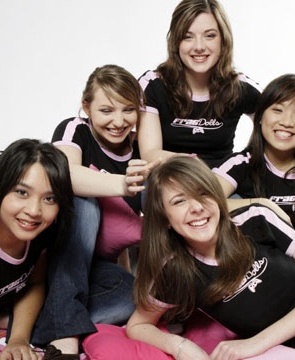Who's that girl?
Exactly who are Nintendo and Sony trying to woo with their mutually blushing bribes?

What kind of girls go for pink? Some women wear pink to revel in its femininity, while for others a pink iPod is a statement of technophilic irony. There are women who won't touch the stuff, considering it beyond the pale. Some find it's simply a bad fit for their skin colour.
Then there are the Samurai warriors, who for centuries revered pink cherry blossoms because the flowers fell and died while still in their prime.
It's complicated.
With its pink DS, Nintendo seems to have plumped squarely for the 'girly' market, with its case backed up by existing young female-friendly DS titles like Nintendogs, Brain Training and, erm, Garfield.
Meanwhile, with its pink PSP Sony has taken the opposite tack and gone for full-on Grrl Power. Its PSP sponsorship deal with pop-punk princess P!NK is: "much more than just launching a new colour. It is about a confident and powerful attitude for young women." Or so said Stephane Hareau, PSP senior brand manager for Sony Computer Entertainment Europe, on announcing the console.
Girls or grrlz? Fluffy women or gritty gamers who just happen to wear bras? It's no easier for games companies to target one market segment without annoying another than it is for us to avoid offending some readers with gaming's near-ubiquitous use of the word 'girl' for grown-ups. Just look at the stick Ubisoft has got for its fairly succesfull Frag Dolls concept (French incarnation pictured above), which puts a sponsored team of female gamers in the public spotlight.
It's not hard to see the industry's motivation, either. Recent research by games publishing giant Electronic Arts revealed that only 40 per cent of teenage girls play video games as opposed to 90 per cent of teenage boys. That means a huge market remains untapped.
So which particular part of the three billion female population is Pink Friday aimed at? Will these pink pocket devices home in on their targets like fashionistas at the Harvey Nick's sales, or have the companies just jumped on each others' bandwagon?
We took to the streets of London to see if Sony and Nintendo have been looking at their market through rose-tinted spectacles.
Chasing the ladies
First stop, a high street GAME store. Things look pretty good on the girls-in-gaming front: pink DS Lite posters flank the entrance, two women loiter in the aisles and there's even a pretty young women behind the counter. But this particular outing ends 2-1 to the boys – the female customers are both shopping for their teenage sons.
Feeling slightly disheartened, we go in search of more girls to ask about their secret gaming habits, and to see if a pink DS Lite or PSP could tempt them over to the dark side.
 We find the lovely Amber, a 20-year old from London, enjoying coffee with some friends (at least until we start badgering her).
We find the lovely Amber, a 20-year old from London, enjoying coffee with some friends (at least until we start badgering her).
"Yes, I have played games in the past" she says, citing ancient PC adventure Day of the Tentacle as one of her favourites. But when quizzed on handheld gaming, things take a turn for the worse.
"I once asked a boyfriend to buy me something pretty for my birthday" she says, obviously still unimpressed by the punchline, "and he bought me a Game Boy Platinum".
Ah. So you won't be buying a new handheld console in pink then?
"Erm, no".
If it's not fancy packaging that's going to woo the girls, then what else can Sony and Nintendo do? Judging by Amber's reaction, they're going to have to go a bit more than skin deep.
 Jessica, 20, and Christina, 20, both students, have also had experience with games. "N64, PlayStation, Game Boy, Sega," Jessica reels off, adding, "does Tetris count too?"
Jessica, 20, and Christina, 20, both students, have also had experience with games. "N64, PlayStation, Game Boy, Sega," Jessica reels off, adding, "does Tetris count too?"
When pressed, Christina even admits to a spot of pocket gaming. "This is really embarrassing, but I do play noughts and crosses on my mobile phone," she says.
But would she ever buy and download a game for her mobile? "God no!" she exclaims. Gaming, chips in pal Jessica, is for people "with too much time on their hands."
 As for Marianna, 23, she regularly plays Snake on her mobile but when shown LocoRoco on PSP she simply says: "I'm just not interested".
As for Marianna, 23, she regularly plays Snake on her mobile but when shown LocoRoco on PSP she simply says: "I'm just not interested".
The Pocket Gamer boys tell me they get that all the time.
Women on women
Maybe it was the girls we asked – in case you're wondering, there really are plenty of sisters doing it for themselves.
For example, an instamatic and rather random girl-gaming bookmark list could take in: the rioty-pink Grrl Gamer, the tomboy-ish Killer Betties, Game Girlz ("from a Girlz perspective"), the hardcore-styled Game Vixen, and for any geeks who are reading like the one writing, the pleasingly cerebral blog Game Girl Advance.
Spend a bit of time on those and similar sites, and you may well conclude that David Gardner, chief operating officer for Electronic Art's worldwide studios, had a point when he said: "Girls don't want 'pink games'," as he recently told the BBC. "They're not trying to play girly games where Paris Hilton and Britney Spears go shopping and put make-up on… they want relationships, they want to be able to chat."
But with ten shooters or driving games for every Animal Crossing, those sorts of experiences remain few and far between. To return to Pink Friday, they're certainly a world away from the wallpapering job of a cheerfully – or even a 'confident and powerfully' – rosy-hued console.
It all leaves Sony and Nintendo in quite a sticky situation. If a significant number of the 60 per cent of young women who the hardware maker's are trying to attract still feel there's a stigma attached to gaming, then a simple dye job is unlikely to rock their world. To attract those unconvinced females, pocket gaming needs to further change how gaming is perceived, and the kinds of games it offers.
Either that or Sony and Nintendo's next makeovers should come courtesy of Louis Vuitton and Mulberry…